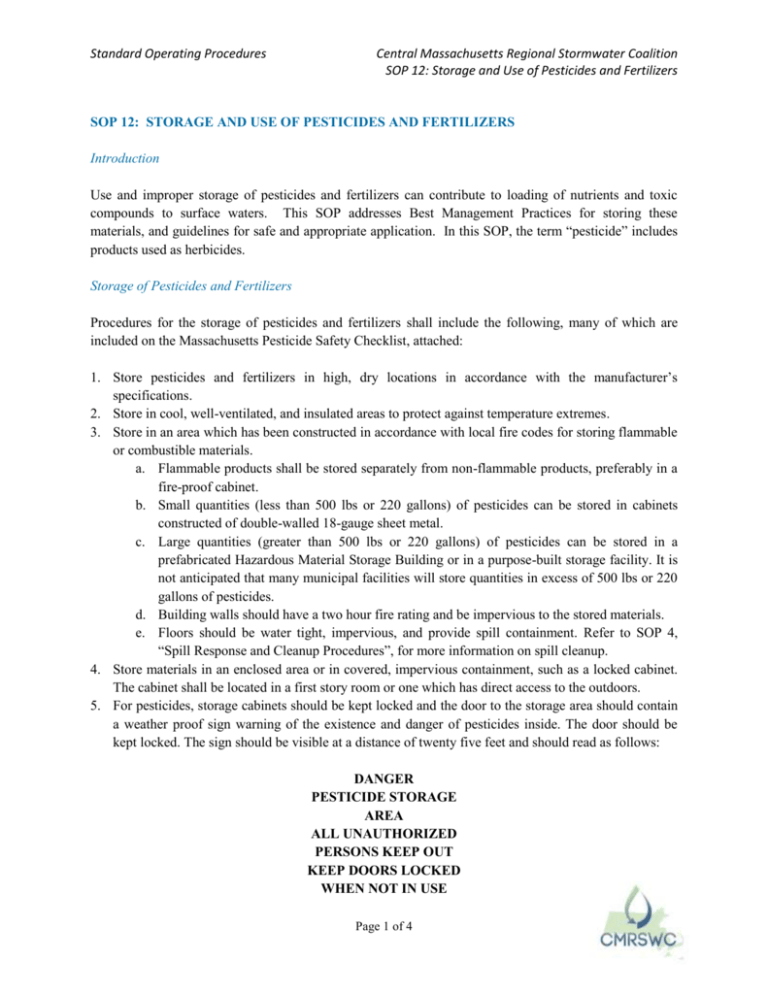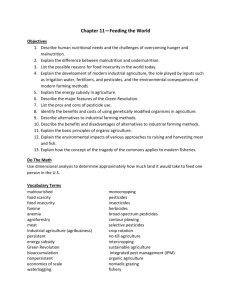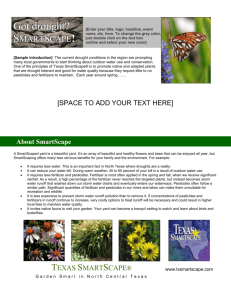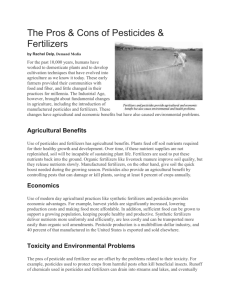Standard Operating Procedures Central Massachusetts Regional
advertisement

Standard Operating Procedures Central Massachusetts Regional Stormwater Coalition SOP 12: Storage and Use of Pesticides and Fertilizers SOP 12: STORAGE AND USE OF PESTICIDES AND FERTILIZERS Introduction Use and improper storage of pesticides and fertilizers can contribute to loading of nutrients and toxic compounds to surface waters. This SOP addresses Best Management Practices for storing these materials, and guidelines for safe and appropriate application. In this SOP, the term “pesticide” includes products used as herbicides. Storage of Pesticides and Fertilizers Procedures for the storage of pesticides and fertilizers shall include the following, many of which are included on the Massachusetts Pesticide Safety Checklist, attached: 1. Store pesticides and fertilizers in high, dry locations in accordance with the manufacturer’s specifications. 2. Store in cool, well-ventilated, and insulated areas to protect against temperature extremes. 3. Store in an area which has been constructed in accordance with local fire codes for storing flammable or combustible materials. a. Flammable products shall be stored separately from non-flammable products, preferably in a fire-proof cabinet. b. Small quantities (less than 500 lbs or 220 gallons) of pesticides can be stored in cabinets constructed of double-walled 18-gauge sheet metal. c. Large quantities (greater than 500 lbs or 220 gallons) of pesticides can be stored in a prefabricated Hazardous Material Storage Building or in a purpose-built storage facility. It is not anticipated that many municipal facilities will store quantities in excess of 500 lbs or 220 gallons of pesticides. d. Building walls should have a two hour fire rating and be impervious to the stored materials. e. Floors should be water tight, impervious, and provide spill containment. Refer to SOP 4, “Spill Response and Cleanup Procedures”, for more information on spill cleanup. 4. Store materials in an enclosed area or in covered, impervious containment, such as a locked cabinet. The cabinet shall be located in a first story room or one which has direct access to the outdoors. 5. For pesticides, storage cabinets should be kept locked and the door to the storage area should contain a weather proof sign warning of the existence and danger of pesticides inside. The door should be kept locked. The sign should be visible at a distance of twenty five feet and should read as follows: DANGER PESTICIDE STORAGE AREA ALL UNAUTHORIZED PERSONS KEEP OUT KEEP DOORS LOCKED WHEN NOT IN USE Page 1 of 4 Standard Operating Procedures 6. 7. 8. 9. 10. 11. 12. 13. 14. 15. 16. 17. 18. Central Massachusetts Regional Stormwater Coalition SOP 12: Storage and Use of Pesticides and Fertilizers The sign should be posted in both English and the language or languages understood by workers if this is not English. Pesticides shall not be stored in the same place as ammonium nitrate fertilizer. Separate pesticides and fertilizers from other chemical storage and other flammable materials. Label all containers with date of purchase, and use the older materials first. Clearly label all secondary containers. Never leave unlabeled or unstable pesticides and fertilizers in uncontrolled locations. Maintain a current written inventory of all pesticides and fertilizers at the storage site. Order for delivery as close to time of use as possible to reduce the amount of chemical stored at the facility. Order only the amount of materials needed in order to minimize excess or obsolete materials, which require storage and disposal. Regularly inspect storage area for leaks and spills. Storage area should be equipped with easily accessible spill cleanup materials and portable firefighting equipment. Emergency eyewash stations and emergency drench showers should be located near the storage area. Ensure that contaminated waste materials are kept in designated containers and stored in a labeled, designated, covered, and contained area. Dispose of excess or obsolete pesticides/fertilizers and associated waste materials in accordance with the manufacturer’s specifications and all applicable regulations. Use and Application of Fertilizers All fertilizer products manufactured or distributed in the State of Massachusetts must be registered with the Department of Agricultural Resources. There is no licensing or certification required for individuals in order to purchase or apply fertilizers. Procedures for the use of fertilizers include the following: 1. Fertilizers should only be applied by properly trained personnel. 2. Perform soil testing before evaluating and choosing a fertilizer. The quantity of available nutrients already present in soil will determine the type and amount of fertilizer that is recommended. The soil test will also determine soil pH, humic matter and exchangeable acidity, which will indicate whether pH adjustment is required for a fertilizer to work efficiently. A soil test should be completed at each facility, as soil type and quality can vary widely within a single community. Type of turf and turf use should also be considered in fertilizer selection. 3. Fertilizer selection shall take into account any surface waters within the watershed that are impaired for nutrients. Future regulatory actions may limit use of many fertilizers within these watersheds. 4. Calibrate application equipment regularly to ensure proper application and loading rates. 5. Never apply fertilizers in quantities exceeding the manufacturer’s instructions. 6. Time fertilizer application periods for maximum plant uptake, usually in the fall and the spring. 7. Do not over-apply fertilizer in late fall to “use it up” before winter. The effectiveness of fertilizer will not reduce when stored. Page 2 of 4 Standard Operating Procedures 8. 9. 10. 11. 12. 13. 14. 15. 16. 17. 18. Central Massachusetts Regional Stormwater Coalition SOP 12: Storage and Use of Pesticides and Fertilizers Do not fertilize during a drought or when the soil is dry. Never apply fertilizer to frozen ground. Never apply fertilizer if it is raining or immediately before expected rain. Mix fertilizers and clean application equipment under cover in an area where accidental spills will not enter surface water or groundwater and will not contaminate soil. Do not hose down paved areas after fertilizer application if drainage will enter to an engineered storm drain system or drainage ditch. Apply fertilizers in amounts appropriate for the type of vegetation to minimize losses to surface water and groundwater Where applicable, till fertilizers into the soil rather than dumping or broadcasting (proper application techniques will depend on the types of soil and vegetation). If phosphorous fertilizer is used when re-seeding, mix the phosphorous into root zone. Do not apply directly to the soil surface. Use alternatives to chemical fertilizers, such as natural compost and organic fertilizers, which are beneficial to soil organisms. Avoid combined products such as “weed and feed,” which do not target specific problems at the appropriate time. Use slow-release fertilizer for turf grass. Use and Application of Pesticides The State of Massachusetts has a stringent program for registration of pesticides and certification of those authorized to apply them. Once a pesticide has been approved for use by the U.S. EPA, it must be registered by the Massachusetts Pesticide Board Subcommittee prior to being distributed, purchased, or used in Massachusetts. Pesticide classification in Massachusetts is based on the potential adverse effects the pesticide may have on humans or the environment. “Restricted Use” pesticides can only be sold by Licensed Dealers to Certified Applicators, while “State Limited Use” pesticides may be restricted to use by certain individuals or require written permission from the Department of Agricultural Resources prior to use. Legal application of pesticides must be performed by an individual licensed or certified by the Massachusetts Department of Agricultural Resources. A Commercial Applicator License is required for applying general use pesticides, and a Commercial Applicator Certification is required for applying restricted and state limited use products. Procedures for the use of pesticides include the following: 1. 2. 3. 4. 5. 6. 7. Pesticides should only be applied by licensed or certified applicators. Calibrate application equipment regularly to ensure proper application and loading rates. Ensure that pesticide application equipment is capable of immediate shutoff in case of emergency. Conduct spray applications according to specific label directions and applicable local regulations. Never apply pesticides in quantities exceeding the manufacturer’s instructions. Apply pesticides at the life stage when the pest is most vulnerable. Never apply pesticides if it is raining or immediately before expected rain. Page 3 of 4 Standard Operating Procedures Central Massachusetts Regional Stormwater Coalition SOP 12: Storage and Use of Pesticides and Fertilizers 8. Do not apply pesticides within 100 feet of open waters or of drainage channels. 9. Establish setback distances from pavement, storm drains, and water bodies, which act as buffers from pesticide application with disease-resistant plants and minimal mowing. 10. Spot treat infected areas only instead of the entire location. 11. Mix pesticides and clean application equipment under cover in an area where accidental spills will not enter surface water or groundwater and will not contaminate soil. 12. Do not hose down paved areas after pesticide application to a storm drain or drainage ditch. 13. Recycle rinsate from equipment cleaning back into product. 14. Choose the least toxic pesticide that is still capable of reducing the infestation to acceptable levels. 15. Use alternatives to pesticides, such as manual weed control, biological controls, and Integrated Pest Management strategies (learn more at http://www.mass.gov/agr/pesticides/ publications/docs/IPM_kit_for_bldg_mgrs.pdf). 16. For use of herbicides, reduce seed release of weeds by timing cutting and pesticide application at seed set. Select vegetation and landscaping that is low-maintenance, in order to tolerate low levels of weeds without interfering with aesthetics. Attachments 1. Massachusetts Pesticide Safety Checklist Related Standard Operating Procedures 1. SOP 4, Spill Response and Cleanup Procedures Page 4 of 4






